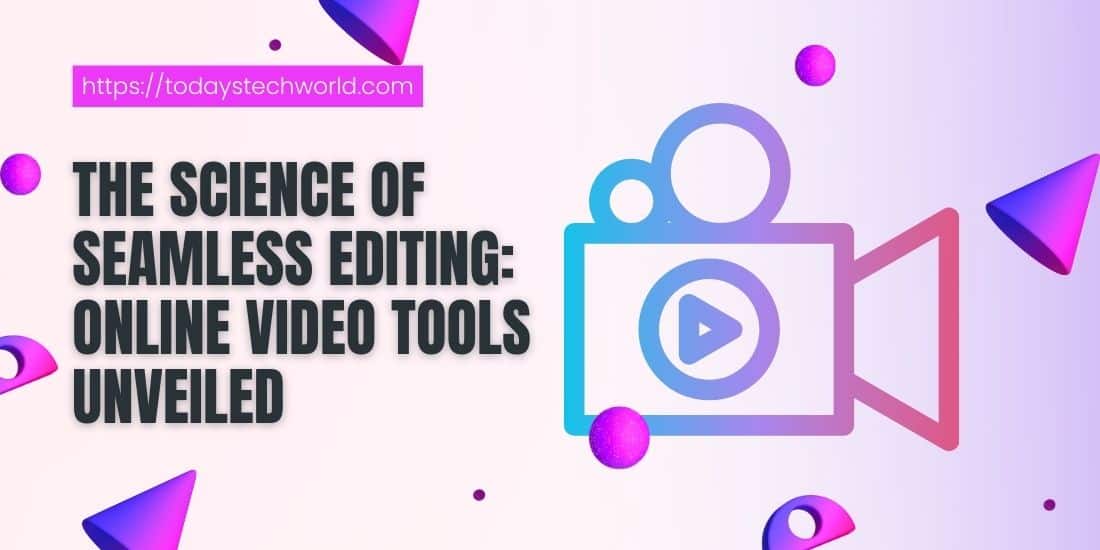Video content has dominated our lives in the era of the internet. Whether we’re viewing videos on YouTube, streaming films and TV series on services like Netflix, or posting our own works on social media, video material is all around us.
Online video editing tools are a fascinating piece of technology that is powering this video revolution. These tools have revolutionized how we edit and manipulate videos, making it simpler than ever to produce footage that looks professional. This blog article will explain the science underlying video editing using internet video tools.
Contents
The Rise of Online Video Editing Tools
Let’s take a moment to recognize the importance of online video editing tools before we go into the technical details. Video editing used to be a difficult operation that used a lot of resources and was called both specialized software and strong hardware. However, the entry threshold has been dramatically lowered with the introduction of internet video editing tools. With the help of these technologies, video editing has become more accessible, enabling anyone with an internet connection to start making videos.

The User-Friendly Interface
The intuitive user interfaces of online video editors have helped them become quite popular. To make video editing accessible to a wider audience, including individuals who might have little to no prior editing knowledge, these interfaces are created with the user experience in mind.
The timeline, a graphic depiction of your video production, sits at the center of these user interfaces. You can organize and change your video’s audio tracks, video clips, and other components here. The timeline allows editors to build their stories since it enables exact control over the timing and order of various aspects.
The preview pane offers a real-time preview of your video as an addition to the timeline. The preview pane enables you to see the results of changes such as cutting, editing, or adding effects as you make them. This quick feedback loop improves editing and assists content producers in making wise choices about their work.
The Cloud’s Strength
To offer a smooth editing experience, online video editing programs take advantage of cloud computing. Much of the work takes place on remote servers rather than exclusively using your local device’s processing power. This strategy offers the following benefits:
Performance: Cloud-based video editing makes it possible for users to edit high-quality videos without lag or crashes, even on less capable machines. Powerful cloud servers perform the hard lifting, including rendering and video compression.
Accessibility: From any location with an internet connection, you may view your video editing projects. For content producers who need to work on their projects while on the go, this mobility is a game-changer.
Collaboration: Collaboration is made easier by cloud-based solutions since they let numerous users work on the same project at once. Real-time teamwork is made possible by the instantaneous reflection of changes made by one user for all others.
Automatic Backups: A critical feature for any video creator, cloud storage guarantees that your work is automatically backed up and secured against data loss.
Compression and encoding of video
Video compression and encoding are key technological aspects of online video editing software. When you edit a video online, the tool must re-encode the file in order to properly reflect your changes. These steps involve numerous crucial components:
Transcoding: Transcoding is the process of converting video data between different file formats. For instance, the online tool may convert your source video to a more web-friendly format like H.264 if it is in a high-quality format like ProRes.
Bitrate Control: Controlling the bitrate, which impacts both file size and visual quality, is a key component in video compression. In order to reduce the size of the video for effective streaming or sharing, advanced algorithms make sure that the video quality is maintained.
Frame Rate and Resolution: Users can change the frame rate and resolution of their videos using online tools. Online tools use algorithms to gently accommodate these changes, even when these choices have an impact on the overall quality and file size.
Lossless Editing: Many online video editors provide support for lossless editing for specific operations, ensuring that the video quality endures through numerous edits without degradation.
Real-Time Cooperation
Real-time collaboration is one of the most notable aspects of online video editing software. This functionality uses a variety of technologies in the background, including:
Version Control: Much like software development, video editing projects frequently employ version control tools to keep track of the modifications made by many people. These procedures assist in preventing disagreements and guarantee the smooth completion of group initiatives.
Synchronization: Online tools use synchronization methods to update project files in real time on several users’ devices. This covers adjustments to the project’s timeline, effects, and other components.
Communication protocols: Effective user-to-user communication is necessary for seamless cooperation. To ensure that all contributors are aware of the most recent project status, online tools use communication protocols to convey updates.
Features Powered by AI
Online video editing is increasingly reliant on artificial intelligence (AI). AI algorithms are used for a variety of activities, such as:
Automatic Scene Detection: With the help of AI, editors can more easily navigate and edit big video files by automatically detecting changes in the scene.
Background Removal: Video backdrops may be identified and removed by AI-powered technologies, which is a particularly useful feature for content producers who want to overlay their subjects on various backgrounds.
Content Suggestions: AI is capable of analyzing video content and recommending music tracks, transitions, or even effects that will likely improve the video’s overall quality.
Voice and Speech Recognition: To make it simpler to add captions or subtitles to videos, several web editors use AI-driven voice and speech recognition to transcribe audio.
Image and Object Recognition: AI algorithms are able to recognize objects and other components within video frames, enabling the use of sophisticated effects and animations.
Sharing and Exporting
Online tools make it easier to export and share your work when you’ve finished editing your video. These programs often include a variety of export options, giving you the freedom to select the format, resolution, and quality that best suits the audience and platform for your project.
Online video editors additionally frequently include direct sharing options, enabling users to post their work on social media websites, video-sharing services like YouTube and Vimeo, or create direct download links for their viewers.
Online Video Editing’s Future
The realm of Internet video editing will change in fascinating ways as technology develops. We can assume that:
Enhanced AI Integration: AI-powered features will advance even further, giving creators sage advice and automating tiresome jobs.
Advanced Collaboration: As tools adjust to the requirements of distributed and remote teams, collaboration will become even more fluid.
Immersive Editing: The use of augmented reality (AR) and virtual reality (VR) may become increasingly prevalent, enabling editors to work in immersive settings and test out novel storytelling methods.
Global Accessibility: Online video editing tools will keep closing the digital gap and enabling everyone, regardless of location or technological proficiency, to edit videos.
Conclusion
In conclusion, online video editing software has completely changed how we produce and edit videos. They facilitate real-time collaboration, have an intuitive user interface, make use of powerful video compression and encoding techniques, and have AI-driven capabilities. With the help of these technologies, video editing has become more accessible to users of all ability levels. The science of seamless editing using online video tools will only get more spectacular as technology develops, guaranteeing an exciting future for video content makers around the world.




